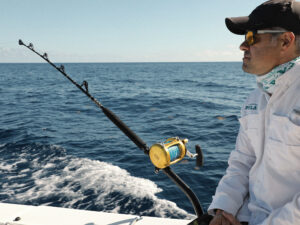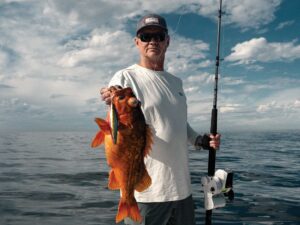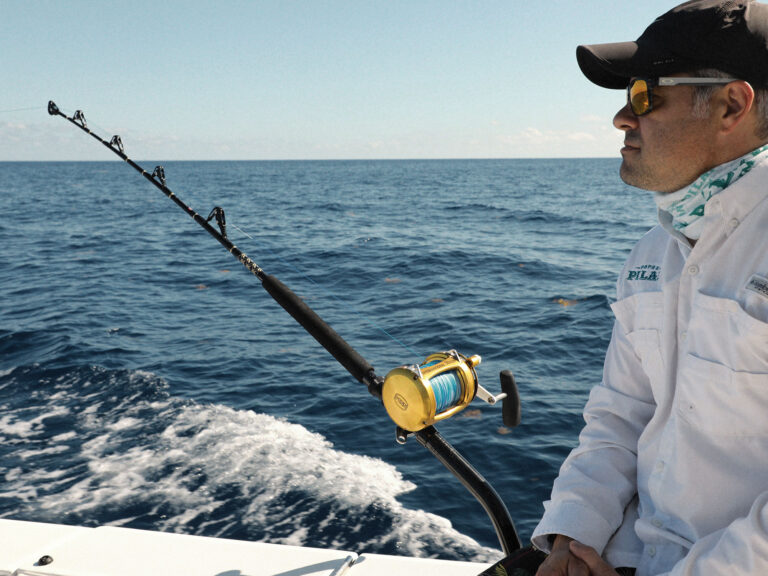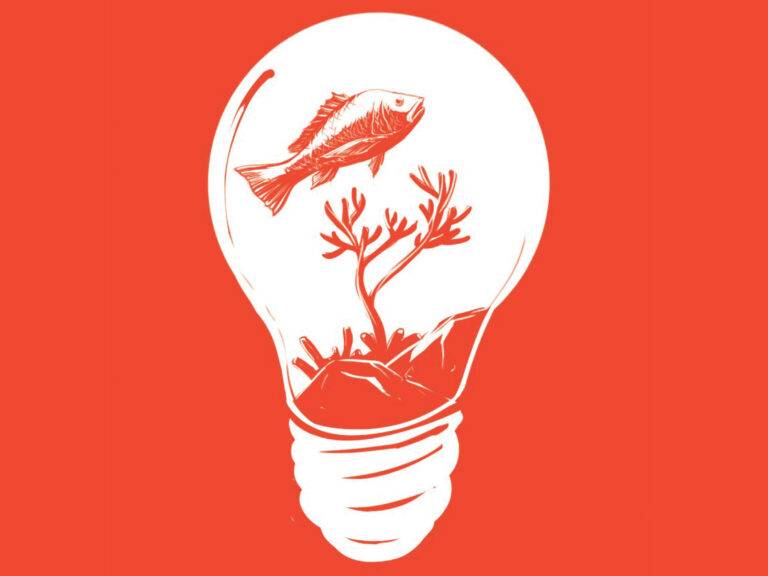
A mild cold front the evening before produced a chilly breeze at the boat ramp that morning when J. Read Hendon and I launched my skiff. It was late September, and Hendon, a fisheries biologist for the University of Southern Mississippi’s Gulf Coast Research Laboratory, in nearby Ocean Springs, and I planned to fish for seatrout. Looking for shelter from the wind, we ended up in Graveline Bayou. And what I saw upon entering this estuarine marsh surprised me.
Graveline Bayou is one of the few relatively undisturbed bayous and small tidal creeks in Mississippi. The majority of the system is a landing area for migratory birds, as well as a nursery for baitfish, crustaceans, and predators the likes of seatrout, redfish and flounder. The shallow marsh bottom is a mix of mud and oyster bars, all of which were vivid with my fishfinder. If you stray from the channel and get too tight against certain areas of the marsh, you’ll know it fast. Fortunately, Hendon knows these waters, and we had to concentrate only on catching fish.
What got my attention most was the number of recreational fishing boats in and near the bayou, topped only by the hundreds, if not thousands, of menhaden that were crammed into that system. There were so many menhaden that I wondered how we’d compete for the seatrout’s attention with our topwater plugs and live shrimp. But we were ready to give it a heck of a try.
Trolling Live Shrimp for Seatrout
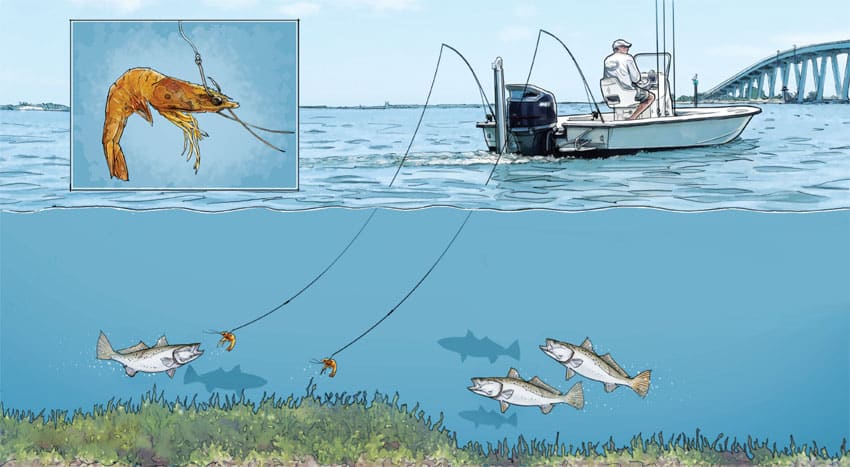
Shrimp-Trolling
Admittedly, I’m a big fan of seatrout, having grown up fishing for them in Miami’s North Biscayne Bay. I still target them, catching them on topwater and swimming baits, soft-plastics, and live baits such as finger mullet, herring, pilchards, croakers and even shrimp. Yet Hendon showed me something new: trolling live shrimp. I’ve certainly drifted with live shrimp before, but never trolled them. And I was a bit skeptical when I saw him rig a small to medium live shrimp on a light spinning outfit, cast it behind the boat and place the rod in a gunwale holder. And if that weren’t enough, he did so with a second outfit on the opposite side of the boat. He then told me to speed up the trolling motor slightly and head up the creek.
My initial thoughts as I chucked my topwater lure from the bow of the boat centered around the shrimp not getting deep enough without weight on the lines, and their propensity to spin. I was confident I was about to take Hendon to school on catching trout until I saw one of his rods bend. He picked it up and reeled in a frisky trout, which was promptly measured, tagged and released for GCRL research. He then re-baited and cast again. Any thoughts I had of him just getting lucky quickly dissipated when the other rod went heavy with a trout. Then the doubleheaders came. Soon Hendon had gotten so far ahead of me with trout that I just had to learn all about his simple setup. There had to be considerably more to the technique than met the eye.
Live Shrimp Catch Seatrout

Hendon was using Penn Conquer 4000 spinners spooled with 20-pound-test braid matched to Penn Torque rods. At the business end was two or three feet of 20-pound-test fluorocarbon leader joined to the braid with a small barrel swivel (to alleviate line twist when trolling). The hook was a 2/0 in-line VMC Tournament Circle. Hendon would dip a shrimp from the boat’s livewell and insert the hook sideways through its rostrum (horn). Hendon believes this arrangement better stabilizes the shrimp when trolling and keeps it alive and active. He’d then cast it behind the boat and free-spool it some 15 to 25 feet.
Exact distance depends on the trolling speed and depth, but when the shrimp bumps or hangs in the shallow bottom, it’s necessary to reel it up a few feet. At this point, you can fish with confidence, knowing your bait is in the strike zone.
And while it could be argued that I was covering plenty of territory with my topwater plug, trolling covers much more terrain and more of the zones most of these fish are in. Every pothole or piece of structure the boat would troll over also saw the pair of shrimp following behind. And they didn’t last very long!
Casting for Seatrout in the Marsh

Throw Plastic
After an enjoyable day in Graveline Bayou, we headed to the Biloxi Marsh for more seatrout the following morning. The Biloxi Marsh is due south of Bay Saint Louis, Mississippi, and also requires a Louisiana fishing license. It’s a bit of a ride over open water from the launch ramp, but once there, you’re in an expansive, beautiful estuary system, one that can be fished when the winds are up too.
Hendon and I concentrated on fishing points, ledges, cuts, pockets and other likely fish-gathering areas. I kept at it with my topwater plug, generating strikes and fish. Hendon abandoned his live-shrimp trolling (we had none that morning) and used a small jig head tipped with a soft-plastic, alternating between a chartreuse-pepper glow paddle-tail minnow and New Penny-hued shrimp. We used the same spin outfits and leaders.
We were catching school-size trout as we moved from spot to spot. There were lots of finger mullet and menhaden throughout this system. Fishing the same waters in another boat was the Isle Casino Hotel Biloxi’s Bobby Carter (aka the Fishing Casino Man) and Justin McGuffie. Carter has been instrumental in bringing Mississippi’s coastal and ocean fishing into the national spotlight through his offshore tournaments and friendships with numerous magazine writers and media personalities.

Though the entire Biloxi Marsh was an amazing experience, two spots in particular really stood out. Hendon had me steer behind a horseshoe-shaped island to a sizable dip in the bottom right off the shore. Here, large trout lay in wait to ambush bait passing with the tide. I was first to cast my topwater plug into the zone, and a big trout crashed it but missed the hooks! I couldn’t believe it! How could a fish miss those hooks? While I was griping about the missed fish, Hendon pitched in his bait — and hooked up. It was a beauty of a trout, evident when it launched from the water. There was just one problem — I had no landing net. Hendon led the fish boat-side, reached down and took a wrap on the leader. But before he could hoist the fish into the boat, it surged and broke the line.
The next memorable spot was where we staked with the Power-Pole and fished a point where water was funneled in from a vast shallow expanse. For a bit the action was fast, and we caught trout on topwaters and soft-plastics. Hendon also scored a couple of nice flounder. When that spot ceased to produce, we fished another section of shoreline. By day’s end, we had released plenty of trout and kept enough plump ones for the big fish dinner Carter was hosting back at the Isle later that evening. And need I even describe how delicious these fresh-caught trout were?
Biloxi Marsh Seatrout Fishing Tackle
Fishing for seatrout is a year-round deal off Biloxi and coastal Mississippi. More slow-trolling and fishing in and along deep holes and ledges occurs during the winter, when cold water sends the fish deep in search of more comfortable temps. Deepwater fishing is also productive during the summer, when fish retreat into deep holes, channels and ledges, seeking cooler water temperatures. Spring and fall find them thriving along marsh edges and oyster reefs, consuming baitfish and shrimp.
- Reels: Penn Conquer 4000.
- Rods: Penn Torque rods, 7-foot.
- Lines: Sufix 832 Advanced Superline, 20-pound-test.
- Leaders: Sufix fluorocarbon, 20-pound-test.
- Hooks: In-line VMC Tournament Circle, 2/0.
- Live bait: Shrimp.
- Lures: Gulp! soft-plastics: chartreuse-pepper glow paddle-tail minnow and New Penny shrimp. Both baits paired with a quarter-ounce jig head.

